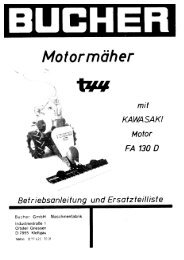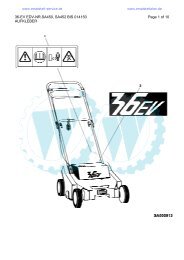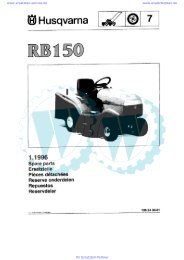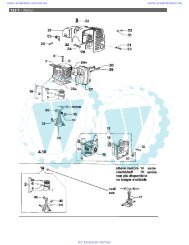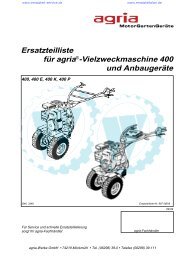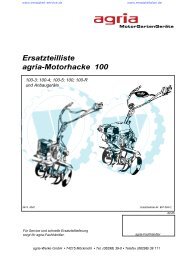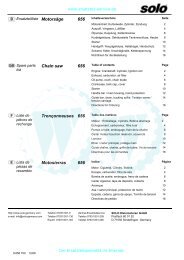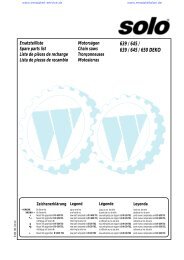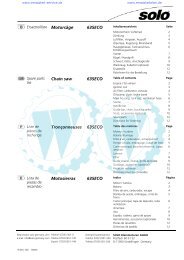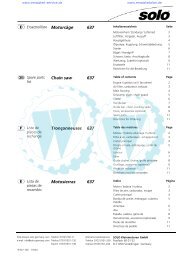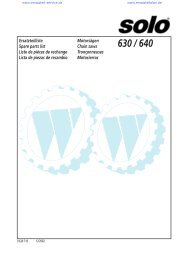Solo Gartengeraete - Ersatzteilplan
Solo Gartengeraete - Ersatzteilplan
Solo Gartengeraete - Ersatzteilplan
You also want an ePaper? Increase the reach of your titles
YUMPU automatically turns print PDFs into web optimized ePapers that Google loves.
www.ersatzteil-service.de www.ersatzteilplan.de<br />
ASSEMBLY<br />
Assembly of Guide Bar and Saw chain<br />
Caution! Switch engine off, remove sparkplug cap (see section<br />
on sparkplug replacement) and wear safety gloves whenever<br />
servicing the guide bar and chain!<br />
Make sure the saw chain is properly tensioned. A sagging chain<br />
can jump out of the bar groove and even break.<br />
WARNING! DANGER OF INJURY!<br />
Note: (fig. 1) The chain guard on some models can<br />
only be removed and installed after release of the<br />
chain brake.<br />
1. Remove bar nuts, bucking spikes and chain guard/hand guard<br />
(fig.2); on used chain saws, clean guide plate (fig.2A) and oil<br />
port and groove (fig.2B).<br />
2. Turn the chain tension screw counter-clockwise (fig.2C) to reset<br />
tension lug (fig.2D) to the very left stop position.<br />
3. Attach guide bar and fit the tension lug (fig.2D) securely into<br />
the lug hole. (Be sure bar lube hole is clean). (fig.3E)<br />
4. Thread saw chain around drive sprocket into the guide bar<br />
groove. Cutters must point upward and toward bar nose (fig.4).<br />
Additionally, insure drive links properly engage the chain sprocket<br />
and the sprocket in the bar nose (if sprocket nose bar).<br />
Note: Some models are equipped with external chain sprockets<br />
(inboard clutch) while others have sprocket behind clutch drum<br />
(outboard clutch).<br />
5. Attach chain guard (hand guard and brake assembly). Initially,<br />
tighten bar nuts only „finger tight“ (fig.5).<br />
Note: On chain saws in which the chain brake is incorporated in<br />
the side cover, make sure that the chain brake is in the released<br />
position before assembly.<br />
6. Lift or support bar nose slightly and hold while using a<br />
clockwise (right hand) turn to tension the chain with the tension<br />
screw (fig.6C).<br />
7. The saw chain is correctly tensioned if the tie straps fit snug<br />
against underside of the guide bar. However, the chain should<br />
be easily rotated on the bar by hand (fig.7).<br />
8. Lift bar nose up, hold or support (fig.8). Now tighten bar nuts<br />
against the chain guard.<br />
CAUTION! The chain saw should only be operated<br />
after complete and correct assembly and<br />
preparation! (See page 19 - Start up operation)<br />
- To prevent mix-up when refulling, fuel and oil tank are marked<br />
with symbols or with "MIX and OIL".<br />
Refuel carefully to avoid spilling of fuel-mixture or chain oil<br />
- Secure each tank cap.<br />
FUEL AND OIL MIX<br />
Fuel: The engine of your chain saw is a high-performance 2 cycle<br />
engine requiring the use of a fuel-oil mixture. The engine can also<br />
be operated with special pre-mixed fuel two-cycle engines available<br />
from trade stores. Important: To mix the fuel, lead-free (unleaded)<br />
regular, lead-free Euro-gasoline or lead-free super (premium)<br />
gasoline can be used (minimum octane 92).<br />
Mix Ratio: We recommend a mix ratio of fuel: oil of 50:1 (2%)<br />
when using our SOLO oil or offered special 2-cycle oil "Castrol<br />
Super TT". When using other brands of 2 cycle oils, we<br />
recommend a 25:1 (4%) (fig.10) ratio. Note: Do not store the<br />
mixture for more than 3-4 weeks.<br />
1000 cm3 (1 Liter)<br />
5000 cm3 (5 Liter)<br />
10000 cm3 (10 Liter)<br />
Castrol-Oil TT<br />
50:1(2%)<br />
20 cm3<br />
100 cm3<br />
200 cm3<br />
Marken 2-T-Oil<br />
25:1(4%)<br />
40 cm3<br />
200 cm3<br />
400 cm3<br />
BREAK-IN INSTRUCTIONS<br />
For the first five tanks full of fuel mixture, avoid excessive RPM<br />
operation of the engine under „no load“ conditions and also<br />
use an initial mixture of ratio 25:1 (4%) even with the<br />
recommended special 2 cycle oil.<br />
To preclude mix up of fuel and bar oil tanks, each tank for fuel<br />
and oil is clearly marked „mix“ or „oil“ (fig.9). Refill tanks carefully<br />
to avoid spilling fuel mix or bar oil.<br />
• Smoking or open flame is prohibited.<br />
• Allow engine to cool before refueling.<br />
• Fuel may contain dissolving substances. Avoid mineral products<br />
contact with skin and eyes.<br />
Wear gloves while refueling. Change and clean protective clothes<br />
frequently.<br />
• Do not inhale vapors.<br />
• Do not spill fuel mix or bar oil. If fuel mix or bar oil have been<br />
spilled, wipe off chainsaw immediately.<br />
Do not allow fuel mix to contact clothing. If fuel mix is spilled on<br />
clothing, change clothing immediately.<br />
• Be sure that fuel mix or bar oil do not contaminate soil (environmental<br />
protection). Always use appropriate protective soil<br />
cover.<br />
• Do not refuel in enclosed surroundings. Fuel vapors collect near<br />
ground level (danger of explosion).<br />
• Transport and store fuel mix and bar oil only in approved and<br />
clearly marked containers.<br />
• Never allow children access to fuel and bar oil.<br />
Handling fuel requires extreme care and caution.<br />
Strict compliance with safety precautions is a must!<br />
FILLING BAR OIL RESERVOIR<br />
Refuel only with engine switched off!<br />
- Clean up area around filler necks.<br />
Bar And Chain Oil<br />
- Remove fuel tank cap and fill up with fuel mix until it reaches The Use of bar and chain oil (low sling, high tack) is<br />
lower edge of filler neck. Remove bar oil reservoir cap and fill to recommended.<br />
lower edge of filler neck.<br />
Note: Whenever reueling, also refill bar oil reservoir. To protect<br />
the environment, use of a bio-degradable bar oil is<br />
13



